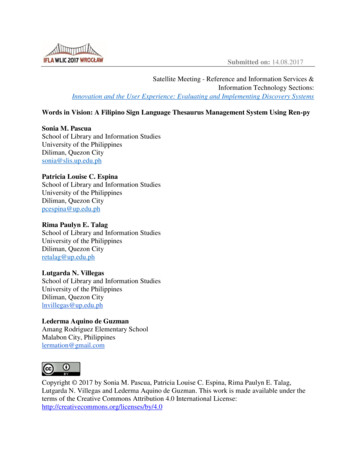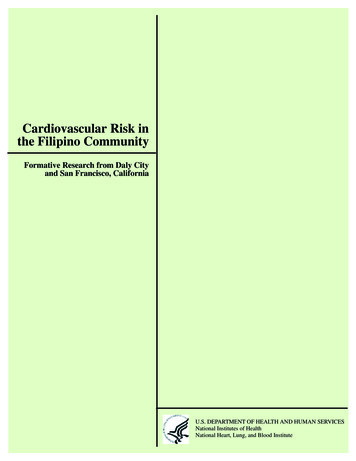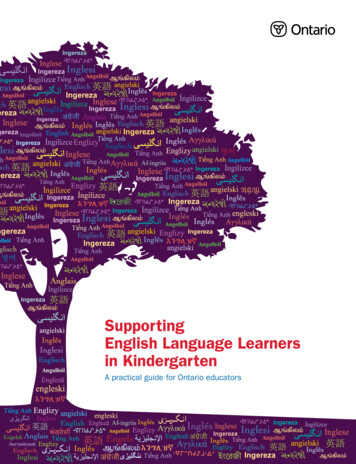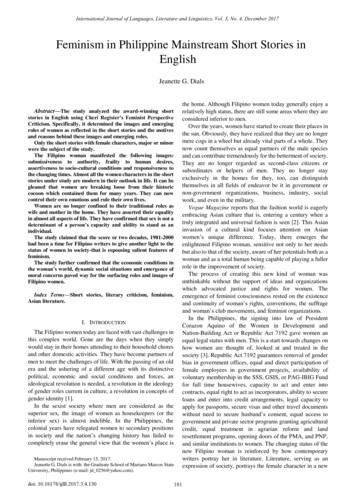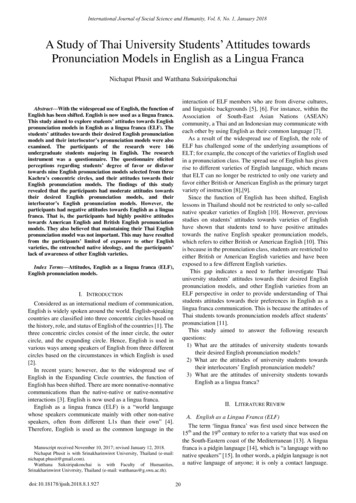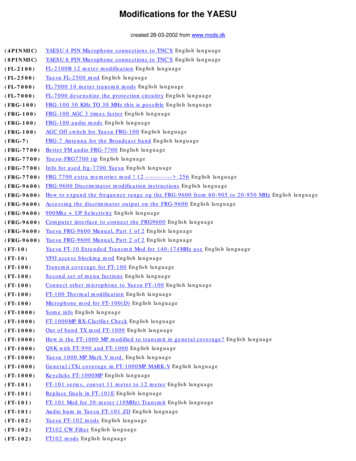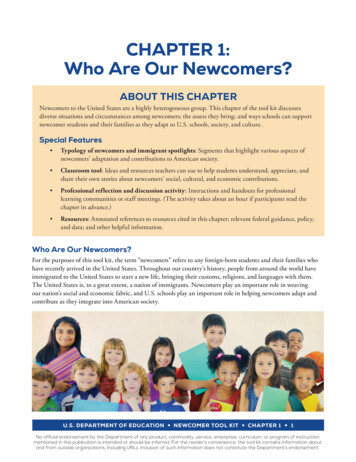
Transcription
English Language Attitude among Filipino Prospective Language Teachers:An Analysis through the Mentalist Theoretical LensRicardo Amparo Somblingo, Ed.D.External Studies – Western Mindanao State UniversityNormal Road, Baliwasan, Zamboanga City, 7000 Philippinesricardo.somblingo@wmsu.edu.phEricson Olario Alieto ,Ph.D.College of Teacher Education, Western Mindanao State University NormalRoad, Baliwasan, Zamboanga City, 7000 Philippinesericsonalieto@gmail.comDr. Ricardo A. Somblingo is currently the dean of the External Studies Office of the WesternMindanao State University. He is a faculty of the College of Teacher Education of the sameuniversity. He teaches in the graduate school program, and he can be reached throughricardo.somblingo@wmsu.edu.phDr. Ericson O. Alieto is a full-time faculty of the College of Teacher Education, WesternMindanao State University. He has participated in international research presentations incountries like Malaysia, Hong Kong and Indonesia for last five years. He is a regional trainerfor English 7, 8 and 9 of the K-12 curriculum. He earned his doctorate degree in AppliedLinguistics at De La Salle University, Taft Manila.AbstractUtilizing the Mentalist Theory, this empirical research purposed to determine the languageattitude towards English of one thousand fifty-four Filipino Elementary Pre-service Teachers.Data collection was realized with a survey questionnaire. The analysis of the data revealed thatthe respondents, on the average, are exhibiting positive attitude towards English. Moreover, thedescriptive statistics reveal that the aspect with the highest mean score is the affectivedimension followed by the conative dimension and coming in last is the cognitive dimension.Furthermore, it was found that there exist a significant relationship among the dimensions ofattitude towards English and the relationship is determined as ‘high correlation’. Detaileddiscussion of the results and implications are provided herein.Keywords: English, Language Attitude, Attitude, Mentalist Theory, Pre-service Teachers1. IntroductionLanguage attitude (henceforth known as LA), as a topic is fluid because it remains to be relevantdespite having been an old subject (Lai, 2005). This is essentially true especially in the case ofthe Philippines, which as a country, has recently shifted from utilizing English as a medium of
instruction (MoI) to using local languages – in the early years of education specifically fromkindergarten to grade 3 (Alieto, 2018).Investigating attitude towards a language or its variety is considered as an essential aspectto explore relating to language policy and planning (Baker, 1992). In a similar vein, Ingram(1989) maintained that policy development and planning that relates to language-in-educationcan never be divorced from construct of LA. It means therefore that a sound languageineducation policy must account research work that probes into determining and understandingstakeholders’ language attitude. Hence, it is no wonder that research focused on determiningattitude towards a language or languages have been realized across different respondents,contexts and times.Ejieh (2004) explored the LA of one hundred six (106) pre-service teachers from a collegeof education in a Yoruba-speaking area in Nigeria towards mother tongue use as language ofinstruction in primary school. The investigation determined that an overwhelming number ofrespondents (84.21%) are unwilling to teach in the mother tongue. The negative stance towardsthe use of mother tongue were reported by the respondents to be due to several reasons. Thetopmost reason is that the respondents believe that mother tongue education negatively affectsthe learning of children of the English language.Similarly, the study of Khejeri (2014) which enlisted forty (40) primary school teachers inHamis District, Western Kenya found that the English language is valued more than the mothertongue. In addition, further analysis of the data revealed that only 2% of the total respondentswanted the use of mother tongue by their learners inside the classroom. This is a very clearindication that the mother tongue is devalued as compared to English, and that there is strongpreference for the use of English. Moreover, the respondents even claimed that there are moredisadvantages than advantages in using the mother tongue in education.With the established trend that English is the preferred language to learn because it isperceived to be most beneficial to learn as it is seen to be the only merchandisable language(Tupas, 2015), it becomes essential to explore the attitude of pre-service teachers specificallythe would-be language educators towards English in the context of its use in the classroom asMoI.Against this set background, the current study is conducted with multiple purposes.Primarily, it intended to determine the language attitude of pre-service language teachers. It isnoted along this line that the determination of the language attitude of the respondents isrealized through the utilization of the Mentalist Theory on language attitude. This is essentiallyimportant as most of investigations on LA view the construct through other theories such asthat of the Behaviorist. However, it is contended that the viewing and understanding LA24
through the theoretical lens of the Mentalist provides a clearer view of the variable. Elaborationof this contention is provided in the succeeding discussion.2. Review of Related Literature2.1 Language AttitudeFrom various angles, the concept ‘attitude’ has been differently defined. The differences of takeabout attitude have stirred “semantic disagreement” (McKenzie, 2010, p.19). On one hand,attitude is defined by Bohner and Wanke (2002) as an evaluation made towards either an objector idea which is referred to as the attitudinal object. On the other hand, Eagly and Chaiken(1993) explained that attitude is a hypothetical construct, which is to mean that attitude is anappraisement of an object, individual, abstract ideas, events and others. Moreover, attitudecannot be directly known or determined except through inference of observable responses.Added to this, attitude can simply be identified as either positive or negative (Gonza lezRian o, 2002).Further, another great concern that arises in the study of attitude in the field of socialpsychology is the overlapping of meaning of attitude with other related terms such as belief,opinion, ideology and others. The tendency to have the meaning of the terms blurred is rootedto their everyday usage outside the bounds of social psychology (McKenzie, 2010). However,it is possible to provide delineation between and among the given seemingly overlapping terms(Shaw & Wright, 1967) by simply being precise with the meaning of the terminologies(McKenzie, 2010).Belief is cognitive in state, and is identified as one component of attitude according to thementalists’ perspective. In addition, as belief can trigger affective reaction, and so can affectivereaction be triggered by beliefs. Beliefs can either be descriptive or prescriptive. If it isdescriptive, it is the kind of belief that relates to the perception about the world; example is thebelief that success in educating people is to an extent dependent on the language to be used asinstruction. Conversely, the prescriptive belief refers to those that contain imperative remarkslike ought and should, example is the belief that young children should be taught in their ownlanguage for them to learn well (McKenzie, 2010).In addition, opinion can be defined as a belief that is expressed or verbalized; hence,opinions can be considered as unconcealed beliefs. The characteristic being overt of opinionsis one great distinction they have over beliefs. In addition, belief is different from attitude inthe sense that contains beliefs or cognitions have no affective reaction unlike attitude which has(Baker, 1992).25
Likewise, ideology is viewed in the field of social psychology as ‘global attitude’,(McKenzie, 2010, p. 20) which means that the term often refers to a broader social perspectiveunlike attitude which is narrower in scope and relates to specific objects (Baker, 1992).2.2 Language Attitude according to the MentalistTwo theories have been utilized by researches as frameworks for the study of languageattitudes, the Behaviorist and the Mentalist (McKenzie, 2010). Both theories assert that attitudeis a result of socialization done over time. However, studies anchored on the perspectives ofbehaviorism argues that all human actions are behavioral units and can be determined throughthe responses an individual makes to social situations. This main argument of the Behavioristwith respect to attitude is that it is a behavioral unit that can be inferred directly from theexhibited responses an individual makes in a particular social context. This means that mereobservation of an individual’s external behavior would be sufficient to determine attitude, andthat introspection of respondents is not a necessity.Furthermore, it means that external behavior is enough as predictor of attitude. As illustrated,if a person expresses dislike about a person, object or thing such behavior can be taken asnegative attitude toward the attitudinal object. In this instance, attitude is seen to directlyinfluence behavior and that behavior reflects attitude (Perloff, 2003). On the contrary, Baker(1992) claims that overt conduct cannot be relied upon as valid predictor of behavior as it maybe deliberately or undeliberately done to conceal inner attitudes. In fact, McKenzie (2010)argued that an increasing number of evidences support that attitude exists in the mind of aperson and is difficult or nigh impossible to be identified or determined directly.Thereupon, this study espouses the Mentalist Theory. The theory views attitude as aninternal state of readiness which cannot be directly observed but is possible to be gaugedthrough introspection which is the basis for the reliance of researchers on respondents’ reportof their perception (McKenzie, 2010). The theory discusses a tripartite model of attitudeformation – the cognitive, affective, and conative components. The theory assumes that attitudeinvolves a cognitive component, an emotional response, and a behavioral predisposition.Firstly, the affective component of attitude, as the theory relates, accounts for the emotionalresponse toward the attitudinal object, in the case of the study is toward English, which caneither be verbal or non-verbal in nature. Verbal affective responses are expressions of emotionsraging from appreciation, disgust to anger. Being expressions of emotion towards the attitudinalobject, verbal responses are easier to determine compared to non-verbal responses. This typeof responses includes easily detected bodily reactions such as but not limited to a frown, smirk,and a smile. There are also bodily changes that are not easy to identify, and an example is26
dilation of the pupil, change in heart rate among others which posts difficulty in determiningas to whether the response is an indicator of a favorable or unfavorable attitude (McKenzie,2010). Moreover, attitude has strong affective component (McKenzie, 2010; Perloff, 2003).For this study, appreciating literary works written in English, and sentimentally associatingone’s membership to the ethnic group and the language are examples of emotional responsetowards the language investigated in this study.Secondly, the conative component of attitude refers to the manner an individual behaves ina particular way. The intended behavior is perceived to be a determinant of attitude. It is positedthat a rational individual compute both the cost and benefit of a particular action. As way ofillustration, a language teacher’s passionate way of teaching a language is a result of theperceived value afforded to the language. The advantages of learning the language influencethe teacher’s actual behavior.Lastly, the cognitive component accounts the held belief of an individual towards alanguage. The perceived value, importance and need of a language and learning the same relatesto the last component of the tripartite model. The theory claims that belief or cognition towarda particular language forms part of the construct attitude. The main advantage of the mentalisttheory of attitude is that “it recognises the complexity of human beings and attempts to explainwhy an individual may hold ambivalent attitudes” (McKenzie, 2010, p.24).3. Research QuestionsThe present investigation directed towards pre-service teachers who are prospective languageteachers purposed to answer the following research problems:1. What is the overall attitude of the respondents towards English?2. What is the language attitude of the respondents according to the aspects as determined bythe Mentalist theory?3. Is there a significant relationship among the aspects of language attitude of the respondents?Hypothesis of the studyHo: There is no significant relationship among the aspects of attitude towards English of the respondents.4. Methodology27
4.1 Research DesignThe present research work utilized a quantitative-descriptive-correlation design. Moreover, thestudy is cross-sectional and non-experimental. Johnson (2000 cited in Perez & Alieto, 2018)claimed that if an investigation intends to describe a phenomenon, such as in this study whichaimed to characterize the LA of the respondents towards the English language, is classified asdescriptive. Moreover, Calderon (2006 cited in Rillo & Alieto, 2018) explained that adescriptive study involves the gathering, computing and tabulating data relevant to prevailingcondition or trend. In addition, as the study involved no utilization of treatment nor ofintervention (Torres & Alieto, 2019), the current research is deemed to be non-experimental.Furthermore, the study is noted as cross-sectional because the gathering of data was completedwithin a relatively short period of time (Setia, 2016 in Buslon & Alieto, 2019).4.2 ParticipantsThe present investigation enlisted a total of one thousand fifty-four (1054) elementaryeducation students in their penultimate year with age ranging from 18 to 39. Additionally, theaverage age is 20.21 with a standard deviation (SD) of 3.124. Descriptive analysis of therespondents’ age revealed that those who reported to be aged 20 forms the largest number ofrespondents with 32.73%. On the other hand, respondents who reported to be 19 years old formthe second largest group with 29.14%. However, the least numbered are those aged 30 andabove. Furthermore, with regard to respondents’ gender, 76% or 802 are females.Addedly, inclusion and exclusion criteria were set to determine whether a candidatequalifies as a respondent of the study in the final administration of the research tool. On onehand, for a candidate to be considered he/she must (1) at least had one month of practiceteaching experience by the time this study was conducted, (2) must had been assigned to teacheither in Kinder, Grade one to Grade three, (3) had had at least one month experience ofteaching in English, and (4) must have had at least one month of teaching experience usingmother tongue as MoI. On the other hand, the following would cause the candidate to beexcluded from participating in the study: (1) if the respondent is graduating but had takenhis/her practice teaching in the previous year by the time this study was realized, and (2) if thecandidate has had less than 20 contact times, by the time the study was conducted.4.3 The SettingThis study aimed at determining the language attitude of the pre-service teachers towardsEnglish in the context of its use in the classroom as MoI was conducted in five (5) locales. Allof the institutions are state-run and offer the bachelor of elementary education or the BEEd28
program. The distribution of respondents across the research sites is as follows: Research Site1 (33.776%), Research Site 2 (31.783%), Research Site 3 (19.165%), Research Site 4 (9.867%),and Research Site 5 (5.408%).4.4. The Research ToolAn attitude scale is a questionnaire structured and fashioned to an overall attitude result(McKenzie, 2010). This means that the sum of the responses of respondents to the differentitems represents one overall attitude. Moreover, a self-devised Attitude towards EnglishQuestionnaire (AEng) was done through extensive literature review and adaptions frominstruments used in the studies of Ejieh (2004), Ndhlovu (2010), Eshghinejad (2016), Sicamand Lucas (2016) and discussion of Khejeri (2014).Preliminarily, as informed through literature, the main components of language attitudewere determined. Item development under each aspect, the conative, cognitive and affective,was done through the authors’ review of studies on the topic. The statements were taken fromvarious authors with modification not limited to alteration of terms and appropriation of contextto fit the context in which the study is realized. Different activities were taken which resultedto addition, deletion and refinement of items. In total, the questionnaire includes 36 items usinga continuous scale (strongly disagree to strongly agree). Twelve (12) items for each aspect oflanguage attitude.Tables 1, 2 and 3 are provided for cross-referencing of the items of the questionnaire withthe dimensions of language attitude. Moreover, the tables also include remark stating fromwhose study the statements took inspiration.Table 1Statements under the cognitive dimensionItemsRemarkItems on survey29
It is possible to teach all primary school subjects Adapted from Ejieh (2004)in English1Teaching in English makes it easier for learners Adapted from Khejeri (2014)to grasp the ideas taught in class4It is possible to teach my own subjectscompletely in EnglishAdapted from Ejieh (2004)Teaching in English will enable teachers toexpress themselves clearly in class.Adapted from Ejieh (2004)10Teaching in English enables pupils toAdapted from Ejieh (2004)13Teaching in English will make lessonsinteresting to pupils.Adapted from Ejieh (2004)16Education in English will enable parents toparticipate in the education of their children.Adapted from Ejieh (2004)19All technical terms and expressions in myAdapted from Ejieh (2004)22Being good at English helps students study inother subjectsAdapted from Eshghinejad25Giving command in English is more effectivethan in any other languagesAdapted from Sicam and7understand easily.subject area(s) can be easily translated intoEnglishUsing English in class enables students to expressthemselves confidently(2016)28Lucas (2016)Adapted from Khejeri (2014)English is an expressive and descriptiveAdapted from Sicam andlanguageLucas (2016)3134As presented in Table 1, it can be gleaned that seven (7) or 58% of the total items for thisdimension are inspired from that of Ejieh (2004), two (2) or 17% from Khejeri (2014), one (1)or 8% from Eshghinejad (2016), and two (2) or 17% from Sicam and Lucas (2016). Theseitems are distributed throughout the questionnaire every even number.Table 2 presents the statements of the AEng forming part of the affective dimension. Thesestatements involve the emotional response of an individual towards the attitudinal object. Four30
studies (Ndhlovu, 2010; Eshghinejad, 2016; Khejeri, 2014; Sicam & Lucas 2016) mainly serveas guides in the formulation of statements constituting the affective dimension of thequestionnaire.Table 2Statements under the affective dimensionItemsRemarkI like to get news in EnglishAdapted from Ndhlovu (2010)2I appreciate listening to songs in EnglishAdapted from Ndhlovu (2010)5Original Formulation8Adapted from Eshghinejad (2016)11Adapted from Eshghinejad (2016)14Adapted from Eshghinejad (2016)17Adapted from Eshghinejad (2016)20Adapted from Eshghinejad (2016)23Original Formulation26Adapted from Sicam and Lucas29Items on surveyI like it when people talk to me in EnglishI have great interest in learning to speakfluently in EnglishI feel proud when I study or learn aboutEnglishI love studying in English than otherlanguagesStudying English is enjoyableI look forward to the time I teach in Englishin classI feel more confident whenever I speak inEnglish31
I appreciate people greeting me in English(2016)Adapted from Khejeri (2014)32Original Formulation35I want my learners to learn English fluentlyI feel satisfied when my students learn whenI teach in EnglishFrom Table 2, it can be noted that five (5) or 42% are informed by the study of Eshghinejad(2016), two or 17% by Ndhlovu (2010), and by Khejeri (2014) and Sicam and Lucas (2016)both 0.8%, and 3 or 25% were originally developed . Seventy-five percent (75%) of the totalnumber of items in the affective dimension took inspiration from existing studies on languageattitude. On the other hand, 25% of the statements were originally constructed. Table 3 showsthe items classified under the conative or behavioral dimension of the AEng. The studies ofNdhlovu (2010), Eshghinejad (2016), and Sicam and Lucas (2016) served as guides for thedevelopment and construction of items under this aspect. The statements under this aspect oflanguage attitude are the predisposition of an individual to act or behave in a certain way ormanner.Table 3ItemsRemarkItems on surveyStatements under the conative dimensionIf given a choice, I prefer to teach in EnglishOriginal Formulation3I speak in English to friendsAdapted from Ndhlovu (2010)6I will study more about English to be able toOriginal Formulation9Original Formulation12Adapted from Eshghinejad (2016)15Original Formulation18Original Formulation21speak fluentlyWhenever making personal notes, I write inEnglishWhen a person speaks to me in English, Irespond in EnglishI communicate in English whenever I sendmessages thru email and text messagesI think in English32
When I console a friend, I prefer to useAdapted from Sicam and LucasEnglish(2016)I give commands and requests in Englishadapted from Sicam and Lucas2427(2016)I prefer to write to friends and family inOriginal Formulation30Adapted from Sicam and Lucas33EnglishI greet people in English(2016)I choose to speak to family members andAdapted from Ndhlovu (2010)36relatives in EnglishAs seen in table 3, a majority of the items in this aspect is self developed which accounts for50% of the total 12 items. Three (3) items were modified from the study of Sicam and Lucas(2016) accounting for 25%. Two (2) items were from Ndhlovu (2010) accounting for 17 %,and the last item is from Eshghinejad (2016).The total composition of the AEng is as follows: 9 were originally formulated, 7 from bothfrom Ejieh (2004) and Eshghinejad (2016), 6 Sicam and Lucas (2016), 4 from Ndhlovu (2010),and 3 Khejeri (2014). The thirty six (36) items were placed together without marking ofaspects. Further, the items were randomly ordered in the questionnaire to minimize responseset bias (Heppner & Heppner, 2004).4.5 Reliability of the Research InstrumentThe instrument was finalized for pilot testing. Four (4) major content sections are found in thequestionnaire: the cover letter, the demographic profile, the items and the closing instruction.The cover letter includes basic information about the researcher and assurance that theinformation disclosed for this study shall be handled with great confidentiality. In addition, theinstrument was administered for pilot testing to one hundred (100) students who met theinclusion criteria set for this study. Participants for the pilot testing were students from theexternal campus who shall not form part of the sample in the final administration of thequestionnaire for data gathering. The Cronbach’s alpha of 0.947 was the yielded reliability forthe 36 items. George and Maller ( 2003) stated that as a rule of thumb if the value ofCronbach’s alpha is greater than 0.9 it is considered as ‘excellent’, if the value of the Cronbach’salpha is greater than 0.8 it is considered ‘good’, if it is greater than 0.7 it is regarded as‘acceptable’, if greater than 0.6 it is remarked as ‘questionable’, if greater than 0.5 it is noted33
as ‘poor’, and if less than 0.5 it is claimed to be ‘unacceptable’ (p.231). Therefore, the AEngthen is noted to be of ‘excellent’ reliability. Therefore, all of the 32 items were to be includedin the final drafting of the instrument.4.6 Procedure.Shortlisting of the schools to be used as sampling sites was first done through inquiry about thenumber of students that may qualify as respondents of the study. Afterwards, letters were sentto deans and department chairs people seeking permission of the conduct of the study in theirrespective schools. Upon approval of the request, a schedule was set to meet with focal personassigned in each of the site. Series of meet ups were realized to discuss concerns and matters.When all concerns were address, a schedule was determined for the administration of theresearch instruments to the identified respondents in each of the school. Data collection in thefive different sites was set in different schedules as determined by the focal person assigned tofacilitate the investigation. The administration of the tool lasted, on the average, around 45minutes.4.7 Method of AnalysisFor the possible investigation of the questions raised in this study, the numerical data werecoded, entered and checked for error.Analyses were conducted using the SPSS. Strict statistical procedures were observed tolessen bias and be as objective as possible. The raw data generated from the questionnaire wastabulated. Table 4 gives interpretation for the computed arithmetic mean.Table 4Language Attitude ScaleRangeDescriptionInterpretation5.15 – 6.04.32 – 5.14Strongly AgreeAgreeVery PositivePositive3.49 – 4.31Agree SlightlySlightly Positive2.66 – 3.481.83 – 2.65Disagree SlightlyDisagreeSlightly NegativeNegative1.0 – 1.82Strongly DisagreeVery NegativeTo determine the overall LA and the dimensions of LA of the respondents, descriptivestatistics (mean and standard deviation) were used.34
To determine the significant relationships among the dimensions of language attitude of therespondents towards English, Pearson r or Pearson Product Moment Coefficient was used.3. Results and Discussion3.1 Respondents’ Overall Attitude towards EnglishTo determine the overall language attitude of the respondents, the arithmetic means for theaspects of attitude for the three languages were first computed. Afterwards, the overall meansfor the attitudes towards English was also determined. Table 5 presents the mean value andinterpretations. Moreover, the standard deviation (SD) is provided to characterize howdispersed the scores are.Table 5Overall Attitude towards EnglishVariablesOverall Mean4.504Standard DeviationInterpretation0.633PositiveAttitude towards EnglishNote : 6.0-5.15 – Strongly Agree (Very Positive), 5.14 – 4.32 Agree (Positive), 4.31 – 3.49Agree Slightly (Slightly Positive), 3.48-2.66 Disagree Slightly (Slightly Negative), 2.65-1.83Disagree (Negative), 1.82-1.0 Strongly Disagree (Very Negative)Table 5 provides the descriptive analysis of the data. It revealed that the mean value of 4.504with a standard deviation of 0.633 is interpreted as ‘positive’. This means that the respondentsfavour the use of English language in different social dimensions – school, home andcommunity. Moreover, this positive attitude of the respondents towards English is likely heldby most of the respondents as suggested by the low standard deviation. This result confirms theclaim of Tupas (2015) that there exists a prevalence of attitude that favours English.Further analysis of the data revealed the topmost rated items on the AEng questionnaire –presented in Table 5.135
Table 5.1Top Most rated items on the AEng questionnaireStatementsMeanSD Interpretation9I will study more about English to be able to speak fluently5.200.848Very Positive5I appreciate listening to songs in English5.130.919Positive11 I have great interest in learning to speak fluently in English32 I want my learners to learn English fluently5.125.090.9230.869PositivePositive36 I choose to speak to family members and relatives in5.040.939English14 I feel proud when I study or learn about English5.020.869PositivePositiveNote : 6.0-5.15 – Strongly Agree (Very Positive), 5.14 – 4.32 Agree (Positive), 4.31 – 3.49Agree Slightly (Slightly Positive), 3.48-2.66 Disagree Slightly (Slightly Negative), 2.65-1.83Disagree (Negative), 1.82-1.0 Strongly Disagree (Very Negative)Table 5.1 reveals the topmost rated items on the AEng questionnaire by the respondents. Froma total of thirty-six (36) items, six (6) items garnered a mean score of five flat above. Addedly,from the 6 items, only one item is rated ‘very positive’. Further analysis of the data shows thatthe top statements come from two dimensions only – the affective (items 14, 32, and 5) andconative (items 11, 9, and 36). Interesting to note is the fact that none from the most ratedstatements come from the cognitive dimension of language attitude. It is speculated that thepreference for the English language is mainly drawn on conative and affective dimensionsrather than the cognitive aspect. This further means that English is appreciated by therespondents as evidenced by their desire that their pupils to learn the said language, the senseof pride felt whenever they learn English, and liking of listening to music in English.Inaddition, behaviour of the respondents is geared towards learning and gaining greatercompetencies in the language in question. It can noted that the items 11 ‘I have great interestin learning to speak fluently in English’ and 36 ‘I choose to speak to family members andrelatives in English’ are both related to item 9 ‘I will study more about English to be able tospeak fluently’. It is contended that the reason for this is that English is seen as a language ofeconomic importance (Burton, 2013).3.2 Dimensions of the LA of the respondentsT
Mindanao State University. He is a faculty of the College of Teacher Education of the same university. He teaches in the graduate school program, and he can be reached through ricardo.somblingo@wmsu.edu.ph Dr. Ericson O. Alieto is a full-time faculty of the College of Teacher Education, Western Mindanao State University.
